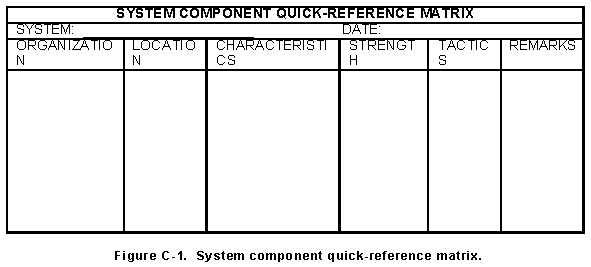
a. Predeployment. Prior to any operation, the MDCI analyst needs to prepare indepth. In addition to researching data on the threat and the AO, the MDCI analyst gathers information and builds a database to serve C-IMINT in the coming operation. During this phase, the MDCI analyst initiates quick reference matrices and the IMINT situation overlay.
(1) Adversary intelligence flight matrix. These matrices are concerned with other platforms used by the adversary. Tracking these collection systems continuously allows the analyst to analyze threat IMINT collection patterns.
(2) System component quick reference matrix. These matrices are concerned with adversary system's capabilities and processing times. This file is part of the database which equates to an OB file on threat IMINT systems shown in Figure C-1.
(3) IMINT situation overlays. These are the paths of adversary intelligence collection flights depicted on the friendly operations graphics. They identify areas susceptible to collection.
b. Friendly patterns. Pattern analysis is the detailed study of friendly activities to determine if a unit performs the activities in a predictable manner, thus creating a monitorable pattern of activity. These actions cue an observer to a unit's type, disposition, activity, and capability. Imagery coverage of the AO is essential for planning and for reference later during operations. Small or intermediate scale imagery covering the entire AO may be obtained from general reference files or national sources and need not be newly flown. The presence of US reconnaissance aircraft making numerous passes over territory belonging to another nation would tip off an impending operation. Therefore, file imagery or imagery obtained by satellite may be the only reference available.

(1) Friendly IMINT is used, when available and of high enough priority, to determine friendly patterns which may be susceptible to IMINT collection. These patterns are key indicators to the enemy of specific operational activities. Patterns usually occur because of a unit's SOP and doctrine. Example patterns include�
(3) Finally, in the overall evaluation, analysts synthesize the separate trends developed during analysis. Such a process identifies the possible compromise of an existing element, activity, or characteristic based on logical relationships and hypotheses developed by analysis. The pattern analysis technique is just one of many techniques designed to help evaluate friendly units for vulnerability to threat IMINT. The process is a continuous one.
(4) Analysis of a unit's movements gives significant clues to its intentions, capabilities, and objectives. By applying this technique against our own units, analysts can identify vulnerabilities. Movement analysis forms an important step in the identification and recommendation of countermeasures.
(a) SLAR is a primary sensor in detecting moving targets or moving target indicators (MTIs) and is usually associated with the special electronics mission aircraft and Joint STARS platform. While the sensor is primarily focused at enemy MTIs, it can be used to identify friendly movement patterns that may also be collected by the enemy.
(b) The tracks created by a unit can give excellent indication of a unit's disposition. Any time a unit moves away from hard packed roads, the danger of leaving track signatures is very high. There are certain countermeasures which should be observed to disguise or eliminate these signatures:
(c) Our IMINT resources can determine the effectiveness of a friendly unit's program to suppress its visual and thermal signatures, including positioning of assets. Friendly aerial reconnaissance is extremely limited and must be planned for well in advance. The following are examples of countermeasures that could be used to reduce our vulnerability to enemy IMINT:
(d) The key to proper positioning of assets on the ground is to use natural features as much as possible. Obvious locations such as clearings may be more convenient but should be avoided at all costs. This includes night operations. Infrared and SLAR missions are particularly effective at night. Units should be well dispersed since a high concentration of tents and vehicles, even well hidden, will stand out on imagery to a trained analyst.
c. Evaluation of countermeasures. For these countermeasures to be effective, every command should develop a self-evaluation system to ensure proper employment.